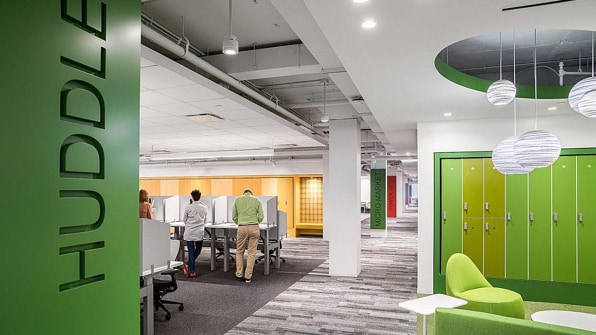Capital One [Photo: courtesy Hollman Lockers]
When Travis Hollman, CEO of locker design company Hollman Inc., was first invited to the site of what would become Apple’s current “spaceship” headquarters, he was confused. “I showed up with my team, and there was a trailer out in the middle of a field,” he says. Apple hadn’t even broken ground yet. “We were like, ‘Why are we even here?’ [Installing] lockers usually comes at the end.” The company informed Hollman that Steve Jobs, before passing away, had made two clear design choices for Apple Park that they intended to honor.
“One was the round glass paneling on the outside of the building,” Hollman recalls. “The other was these lockers.”
Hollman wasn’t surprised that Apple had hired his company to design luxury lockers—Hollman Inc. does the same thing for clients like the Museum of Modern Art, The New York Times, Google, and Goldman Sachs, not to mention scores of elite athletic organizations. But Apple, unsurprisingly, was in a class all its own. “They wanted to have a meeting about the lockers every week,” says Hollman. “That went on for two and a half years.”
But wait: aren’t lockers just metal boxes with doors for throwing your stuff into? How did “locker design” even become a thing?
According to Travis Hollman, it all started with Tiger Woods.
“Golf was on fire [in the late 1990s] because of Tiger, and country clubs were upgrading their golf courses left and right,” he says. “They wanted wooden lockers that looked like cabinetry.” When furniture-makers couldn’t deliver—wood warps and splits in the wet environment of a locker room—companies like Hollman began capitalizing on the new demand for lockers that could take an athletic beating while looking fabulous. Two decades later, Hollman controls 70% of the “nonmetal” portion of this billion-dollar locker market (“only high schools and government entities buy metal lockers anymore,” he says) and helps sports teams recruit talent with $12,000 lockers equipped with video monitors, device charging stations, and motorized shelves.
Rather than just retailing a catalog of mix-and-match prefab storage boxes (although they do that, too), Hollman brands itself as a high-end interior architecture designer that creates bespoke, commissioned solutions that fit individual clients’ needs. Hospitals, spas, and museums—places where people need to store their stuff without feeling like they’re entering a public pool or surrendering personal items in a jail—followed suit. “It just kind of transformed over the years from a basic business to what it is today,” Hollman says.



